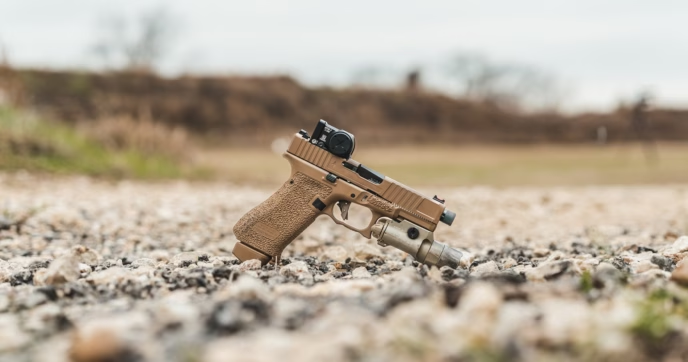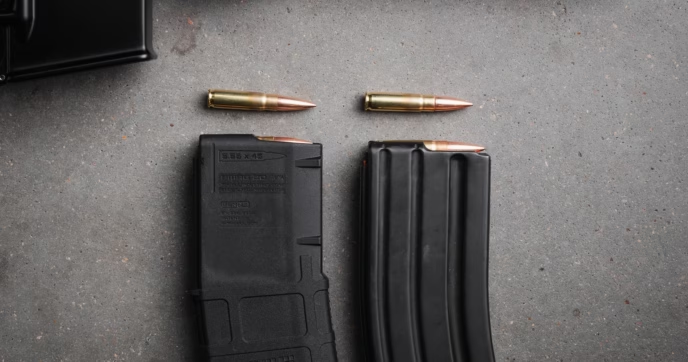While we don’t recommend outfitting your rifle or pistol with every upgrade you can find, one accessory that we simply can’t argue against is a good muzzle device. Nearly every firearm benefits from the addition of an appropriate muzzle device—particularly if that device is a suppressor.
But to add a muzzle device, you need to know your barrel’s thread pitch.

What is Thread Pitch?
Thread pitch refers to the exact pattern of the threads machined into your barrel—assuming your firearm has a threaded barrel, that is. Most rifles now come with threaded barrels, but pistols are more varied. If you’re not sure what a threaded barrel on a pistol looks like, you can check out our article for more information.
While threads may all just look like embossed spirals at a casual glance, they can differ in twist rate and direction, as well as how fine or coarse the threads themselves are.
If you buy a muzzle device or suppressor adapter with the wrong thread pitch, you usually won’t be able to thread it onto your barrel. In a worst-case scenario, you might buy something close to your actual thread pitch, but not exact, allowing it to partially twist on before cross-threading. This can damage your muzzle device, your barrel, or both, so it’s important to verify the pitch of both your firearm and muzzle device before installing.

Common Thread Pitch Variations
Luckily, thread pitches are more or less standardized. There are some exceptions and outliers, particularly for older firearms that were designed before the standard pattern became commonplace or firearms designed for other markets where a different standard is used.
If you find yourself in doubt, you can also refer to your manual or contact the manufacturer to be certain.

Rifle Thread Pitches
Rifles are relatively simple when it comes to thread pitch. The most common thread pitch for .223/5.56 rifles such as AR-15s is 1/2×28. You’ll also frequently see this thread pitch used for smaller centerfire calibers as well. For larger cartridges, such as .300 Blackout, .308 Winchester, or 6.5 Creedmoor, the most common thread pitch is 5/8×24.
Both of these thread pitches are right-hand twist, which is typically considered to be the default unless otherwise specified.
However, as always seems to be the case, there are exceptions. The above standards tend to hold true for most domestically manufactured firearms, but imported ones, particularly from Europe, often use their own standards. M15x1RH (the RH suffix denotes right-hand twist) is common for most rifle calibers, including .223/5.56 and .308 Winchester, although some manufacturers use other pitches like M13x1RH.
AK-pattern firearms have a standard of their own, M14x1LH (Left-hand twist) typically used for most calibers, including 7.62×29 and 5.45×39.
The many different thread pitches on the market can seem daunting, particularly for those looking to use a single .30-cal suppressor for all or most of their firearms. Luckily, there are a wide variety of muzzle devices available that have different thread pitches, but a single shared QD attachment system. This allows users to buy multiple muzzle devices for a suppressor, rather than an individual suppressor for each firearm or thread pitch.

Handgun Thread Pitches
Handgun calibers get even more complicated when it comes to thread pitch.
For most domestically manufactured 9mm handguns, the default thread pitch is 1/2×28, which you may recall is also the standard for .223/5.56 guns like the AR-15. This does not mean that all 1/2×28 muzzle devices can be used interchangeably between the two calibers, as a muzzle device with an aperture designed for 5.56 would be disastrous to use on a 9mm firearm.
Moreover, while that standard holds true for most domestic 9mm pistols and several pistol caliber carbines, many 9mm AR-platform rifles utilize a different standard: 1/2×36.
European pistols, again, have yet another standard, M14.5x1LH, although this one is mercifully consistent across most HK, Sig Sauer, and other (though not all) imported pistols.
Luckily, 9mm suppressors use a piston to attach to the firearm, which can be changed quickly and easily, so you won’t need a dedicated suppressor for each thread pitch—only a different piston.
.40 S&W most commonly uses a 9/16×24 pitch for American firearms and an M14.5x1LH thread pitch for imported ones.
For .45 ACP, the default for domestic firearms is .578×28 for both pistols and pistol-caliber carbines. For most European firearms, including HK’s iconic USP series, the standard is M16x1LH. For the rare owner of the MK23, though, it’s important to note that HK utilizes an M16x1RH thread, making muzzle devices incompatible between the USP series and the MK23.
5.7x28mm handguns most commonly use a 10x1mm thread pitch.

Rimfire Thread Pitches
Rimfire guns are blessedly simple, with the vast majority of both .22LR rifles and pistols using 1/2×28 threads. .17 HMR and .22 Magnum also typically share this thread pitch, making rimfire muzzle devices arguably the easiest to deal with when it comes to compatibility.
Many .22LR suppressors can be used with .17HMR and .22 Magnum as well, so it’s often quite easy to suppress a wide range of rimfire guns with a single suppressor.

Barrel Shoulder Variations
One final variable to be aware of when shopping for a muzzle device is barrel shoulder shape. The shoulder of the barrel is at the very end, just before the threads start. Usually, this is squared off to provide a flat face for the muzzle device to press against, but in some cases, it comes in a different shape: tapered.
Tapered barrel shoulders are machined at an angle in order to allow a muzzle device with a corresponding taper to tighten against it. Theoretically, this design helps to ensure better concentricity and a more secure lockup.
Before purchasing a muzzle device, it’s essential that you verify the type of shoulder your barrel has. Most firearms have a square shoulder, but some, such as Sig Sauer’s MCX series, use a tapered shoulder. Use of a square muzzle device on a tapered barrel shoulder presents a high risk of misalignment, which can be dangerous for a suppressor, or even for a muzzle brake or flash hider if the misalignment is severe enough.

Conclusion
An aftermarket muzzle device is a great addition to nearly any firearm, but it’s important to make sure that it is compatible before you buy. To ensure compatibility, verify both the thread pitch and shoulder shape of your firearm’s barrel and your desired muzzle device.
Of course, if your preferred muzzle device is a suppressor, there’s even more that goes into the buying process. Be sure to check out our guide on how to buy a silencer for a more in-depth look at the process.



